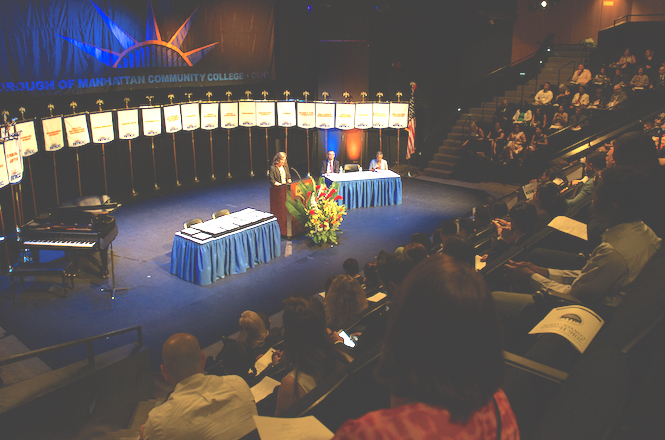Science professor Abel Navarro has a novel perspective on mistakes. As a teacher, mentor and research scientist, he thinks they can be a good thing.
“I don’t believe in constantly looking over a student’s shoulder, making sure they’re doing everything right,” he says. “I trust my students and I think that makes a difference in the learning process. I’ll show them how to perform a technique, have them do it a few times, then step back.” Later on in their careers, he says, mistakes can be costly.
“Now, they’re part of the learning process. They have to learn how to fly—like a bird.”
Navarro’s approach has stood him—and his mentees—in good stead. In the few years since he began his research at BMCC, students working with him have garnered an impressive array of awards and distinctions, presented their work in talks and poster sessions at major conferences, and published numerous papers in academic journals. More to the point, they have taken a major step toward becoming skilled and enthusiastic researchers.
It all started in 2011, when Michelle Naidoo, then a BMCC science major, approached Navarro and asked if she might help out in his environmental science research.
“It didn’t really matter what the project was,” she says. “I just wanted to get my hands on something.” Navarro enlisted Naidoo for a project involving decontaminating wastewater that had been used in chemistry lab experiments.
“The water contained significant amounts of toxic dye—red, blue and violet,” says Navarro. “The goal was to come up with a effective way of purging the pollutants.”
“From zero to five in four months”
To be sure, Naidoo wasn’t new to research. “I’d done a lab workshop the previous summer, so I already had some experience with basic lab techniques,” she recalls. “But I learned a lot more from Professor Navarro—plus, he gave me the freedom to explore the areas I was most interested in and learn at my own pace.”
Word quickly got out that interesting things were happening in Navarro’s lab, that he was open to working with student interns, and that he was a helpful and dedicated mentor. Before the semester was out, four more students had come on board.
“We went from zero to five in four weeks,” Navarro says.
After graduating, Naidoo continued her studies at Hunter College, where she is a pre-med major. She had hoped to connect with a research program at Hunter and apply the knowledge and skills she gained at BMCC. But openings for undergraduates were hard to come by, so she contacted Navarro and asked if she might resume her lab role at BMCC.
“It was great to be back,” says Naidoo.
She has since joined a Hunter research initiative related to cancer cells “and using everything I learned from Professor Navarro.”
Says her mentor, “Michelle was my right hand in the lab. She was efficient and her data was always clean and perfect.”
Teaching in the classroom—and the lab
Having completed his undergraduate studies in chemistry in his native Peru, Navarro emigrated to the U.S. and earned a PhD at NYU, where he focused on proteins and their role in diseases.
“But my main interest was always environmental science, and that’s the field where I’ve been most engaged at BMCC,” he says.
As a scientist, Navarro acknowledges the importance of both research and education, and has made a point of coupling the two in the courses he teaches.
“Research is my way of teaching,” he says. “There is a common belief that community colleges are exclusively for teaching—not research. But BMCC’s research facilities—for biology, physics, chemistry and environmental science—are outstanding.”
An impressive range of awards
The quality of BMCC’s research initiatives has been in evidence in a number of settings. In June, Navarro and his mentees took part in the highly competitive Annual Beacon Conference for Student Scholars. “Out of 120 submissions only 42 were chosen to present their work,” Navarro says. Two BMCC students—Anastasia Sidorenkova (Communications and Media) and Humoyun Musaev (Science)—placed first in their respective disciplines in the Oral Presentations category.
In addition, Navarro has been invited to speak at the International Conference on Earth Science and Climate Change in San Francisco, where two of his students will present posters.
Meanwhile, Navarro and his student scientists have broadened their focus to explore new ways to purge water of toxic industrial decontaminants such as copper and cobalt.
“Several of our students have had their findings published in scientific publications,” Navarro says.
In May, Naidoo gave a presentation at the Earth Science and Climate Conference in Las Vegas, and has co-authored three scholarly, peer-reviewed research papers with Navarro.
“I’m proud of all that we’ve accomplished, but none of it would have been possible without the students,” Navarro says. “They’re the ones who are driving our success and as a teacher and scientist, I am very fortunate to work with them.”




STORY HIGHLIGHTS
- Emphasizes the importance of experiential learning
- Research focuses on finding new ways to decontaminate water
- His mentees win plaudits and top prizes at major scientific conference

